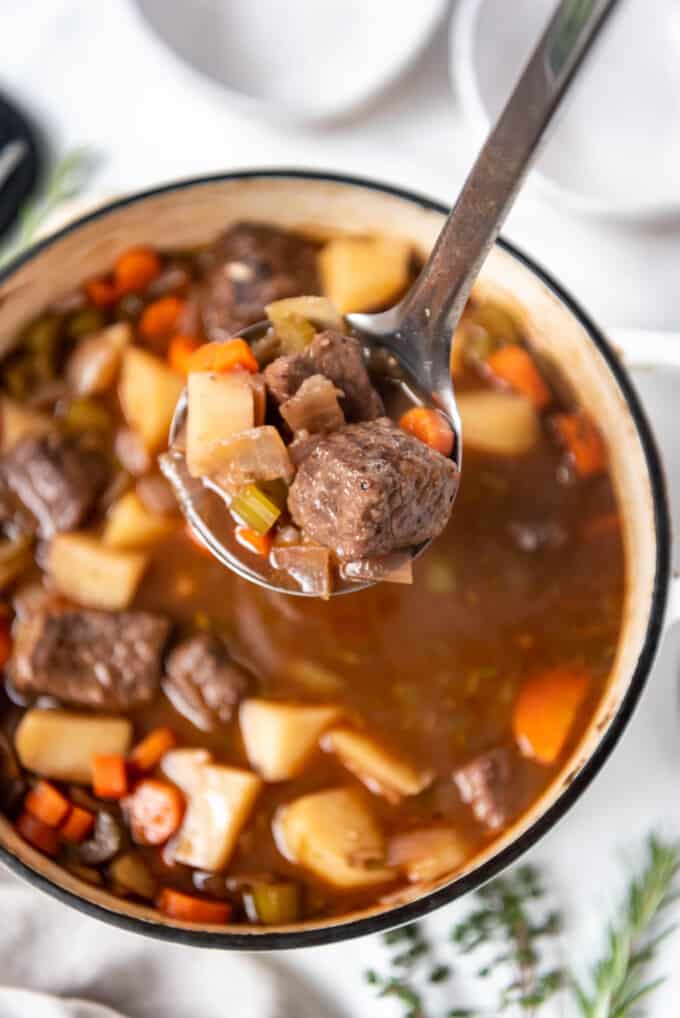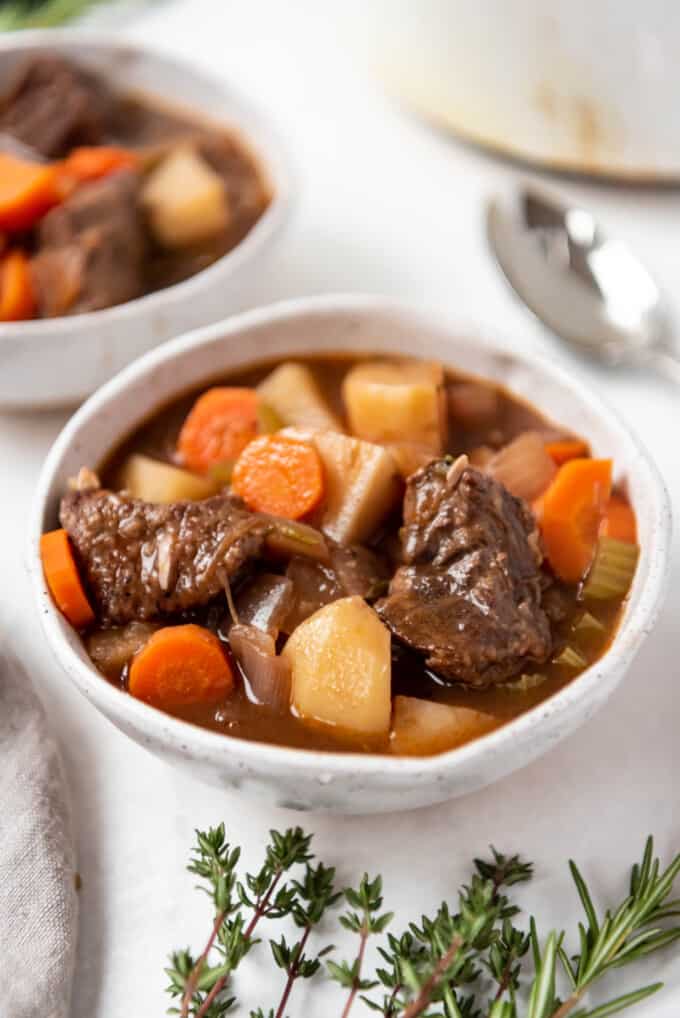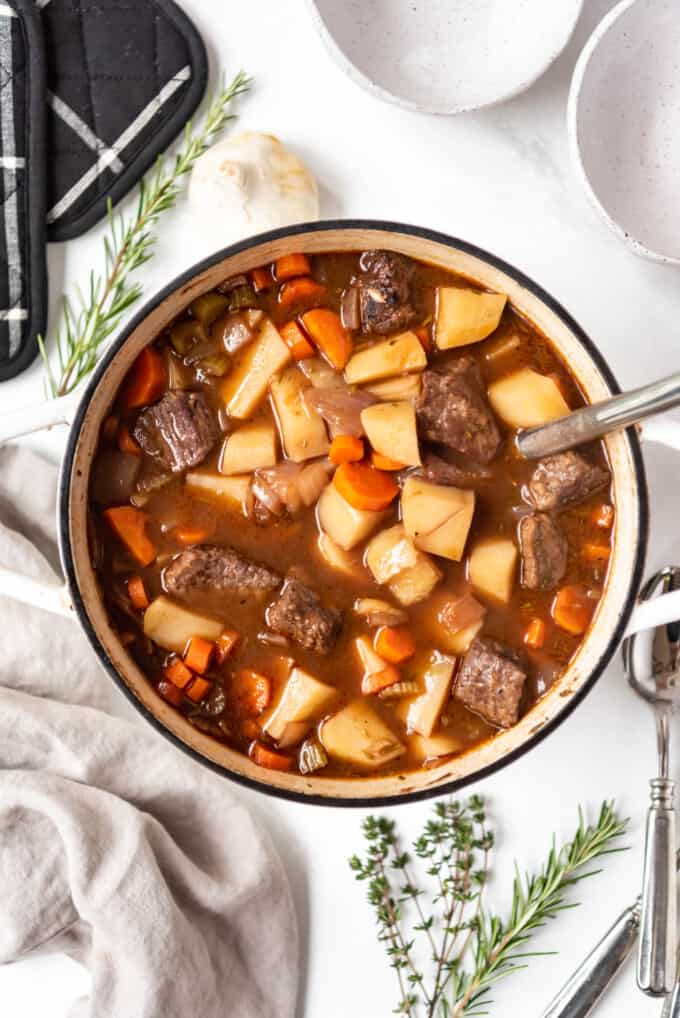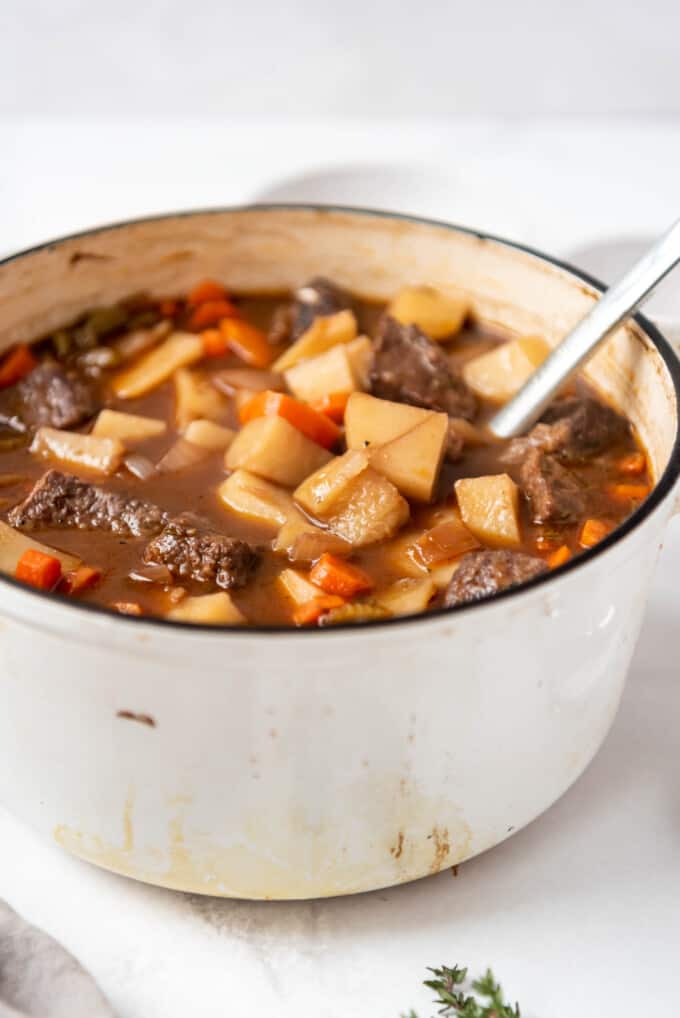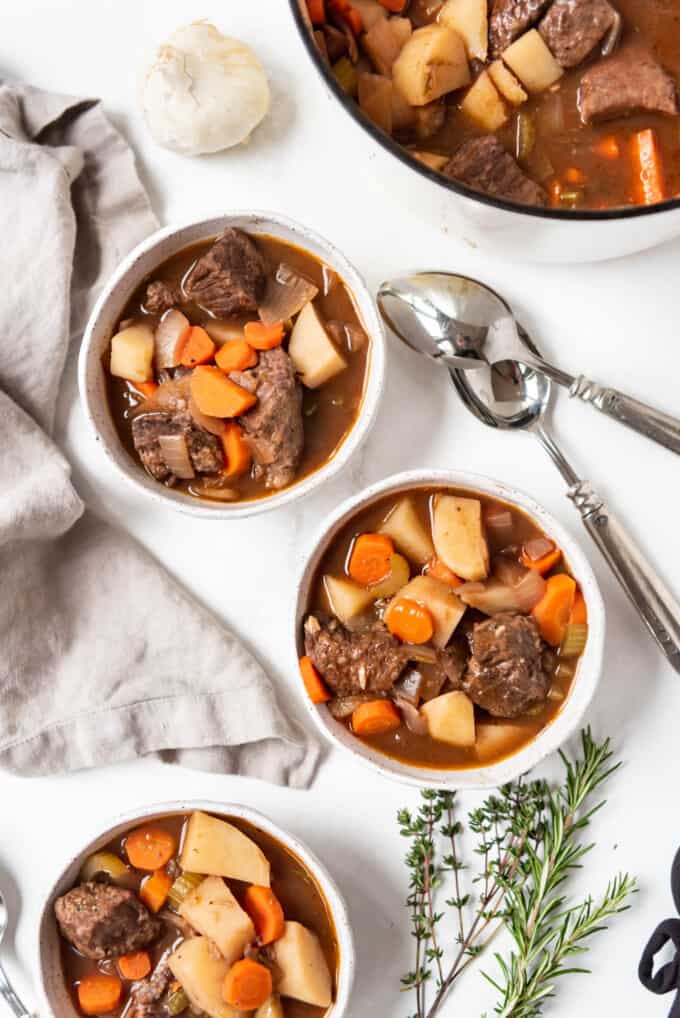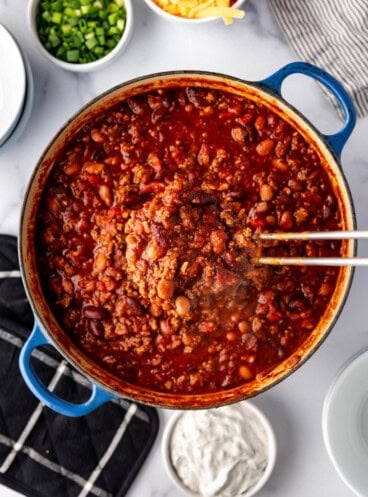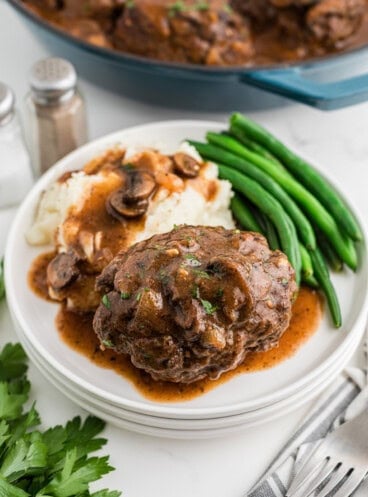This easy beef stew recipe requires only 15 minutes of prep, then a long slow simmer to draw out the best flavor and make for the most tender bites of beef with plenty of chunky vegetables and potatoes. It’s savory, rich, and satisfying.

Table of Contents
- Best Old Fashioned Beef Stew
- Why We Love this Dutch Oven Beef Stew Recipe
- Best Beef Stew Ingredients
- How to Make Beef Stew Dutch Oven style
- Traditional Beef Stew Recipe Tips
- Old Fashioned Beef Stew Substitutions & Variations
- What to Serve with this Traditional Beef Stew Recipe
- Best Old Fashioned Beef Stew Recipe FAQs
- More like this Old Fashioned Beef Stew
- Old Fashioned Beef Stew (Dutch Oven) Recipe
Best Old Fashioned Beef Stew
Too many beef stew recipes are bland or result in overcooked vegetables and tough chunks of meat. Our recipe solves those issues with a low, slow simmer and a few extra ingredients for a rich, deep flavor base that blows every other beef stew away. Your family will definitely thank you for this one.
Some of my other favorite hearty stew recipes are this Authentic San Francisco Cioppino Seafood Stew, my Georgian Chicken Stew, and this Classic Dublin Coddle (Irish Potato & Sausage Stew)! You might also enjoy this beef and noodles recipe.
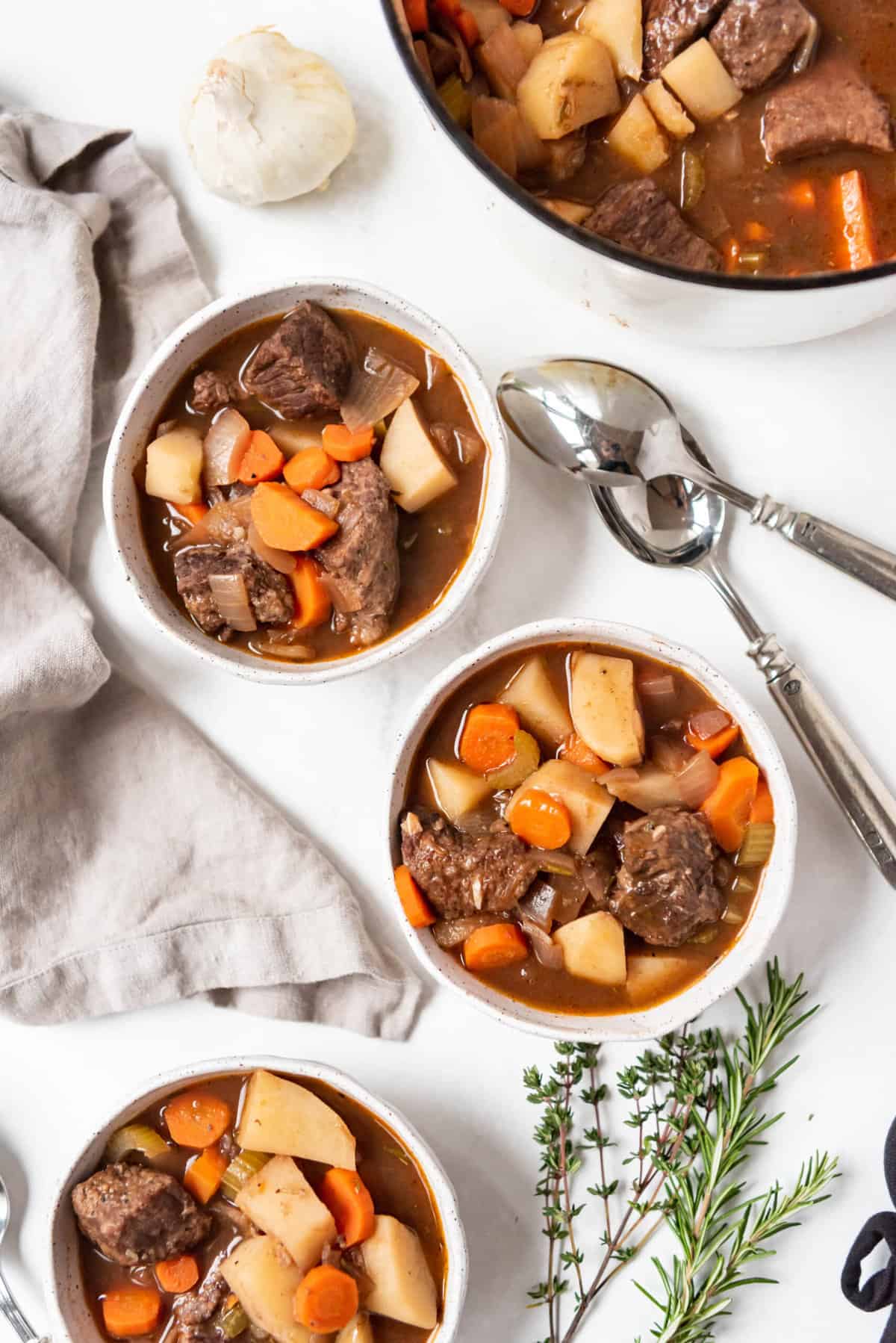
Why We Love this Dutch Oven Beef Stew Recipe
- You can use your favorite cut of beef for this stew, or try it with lamb if you like!
- Use your favorite root vegetables, or seasonal vegetables for this hearty dish.
- It’s an easy one-pot meal that will feed the whole family with very little fuss!
Best Beef Stew Ingredients
Scroll down to the recipe card below this post for ingredient quantities and full instructions.
- Flour – All-purpose flour works protects the meat while it sears while helping to develop a flavorful crust and slightly thicken the stew.
- Seasoning – Freshly ground black pepper, kosher salt, herbs de Provence or a combination of rosemary and thyme, fresh bay leaves, and freshly minced garlic cloves make this dish super flavorful.
- Beef – I like to use a marbled chuck roast that I’ve cut into cubes, but you can use pre-cut beef that is often labled as “beef stewing meat” at the store if you like.
- Oil – Use vegetable oil, olive oil, or canola oil to brown the beef and sauté onions.
- Vinegar & optional red wine – Use red wine vinegar and some red wine to give this stew a deep and rich sweet and savory flavor. The wine is optional and can be replaced with additional beef broth, but I do love the complexity it gives to this recipe.
- Broth – Low-sodium beef broth is best to allow you to control the saltiness of the stew while adding a depth of flavor that is great for cooking all the vegetables.
- Vegetables – We’ll use the classic trifecta of onion, carrots, and celery for this stew as well as Russet potatoes, and peas to bulk it out and add even more nutrients!
- Tomato – Use tomato paste to thicken the sauce and add a great tomato flavor to the mix.
- Worcestershire sauce – This adds a wonderful umami flavor that blends so well with the meat and vegetables.

How to Make Beef Stew Dutch Oven style
This is an easy recipe, but I’ve included step-by-step instructions and process photos to help you out if needed!
- Coat beef. Season the beef with salt and pepper, then toss with flour to coat.
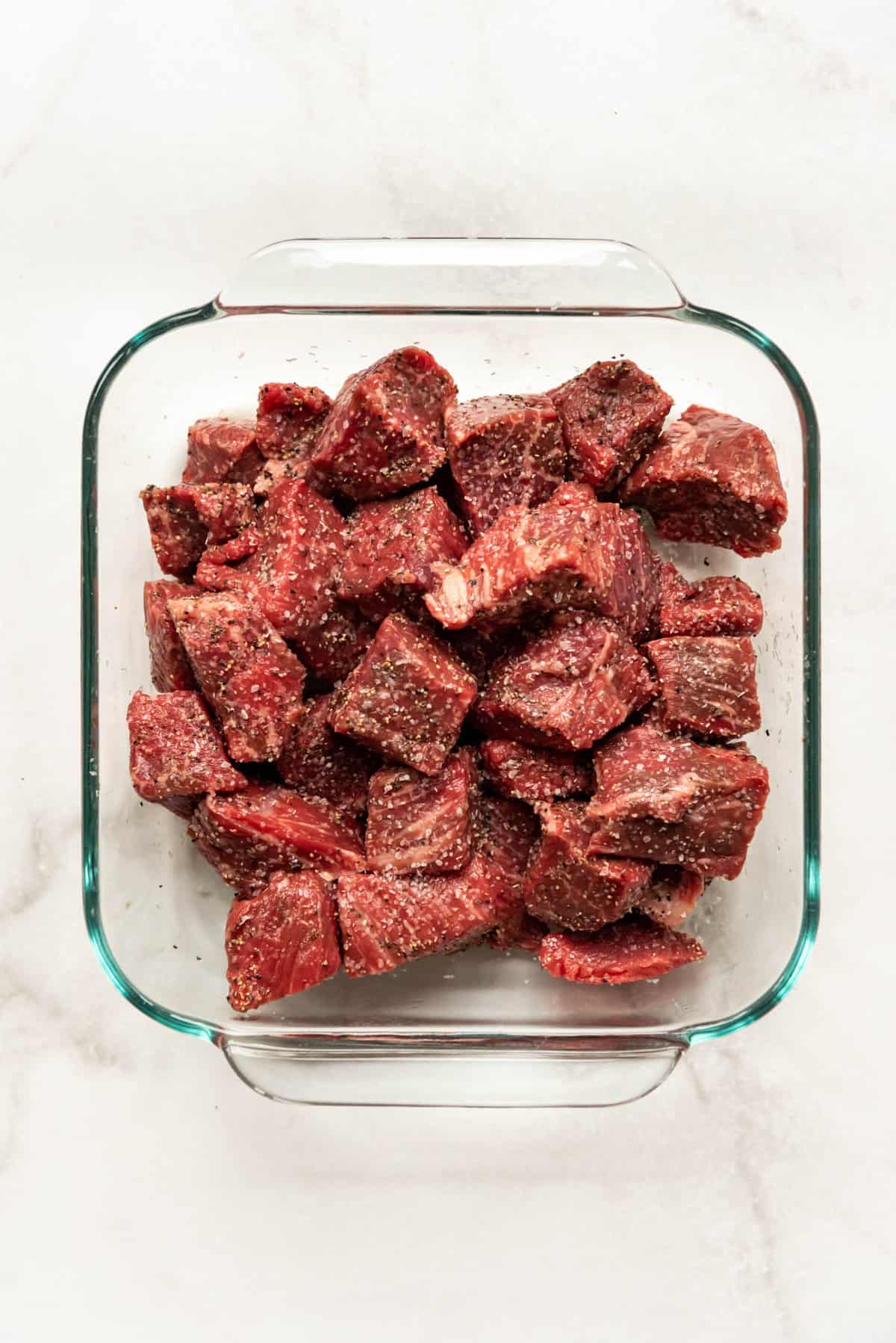
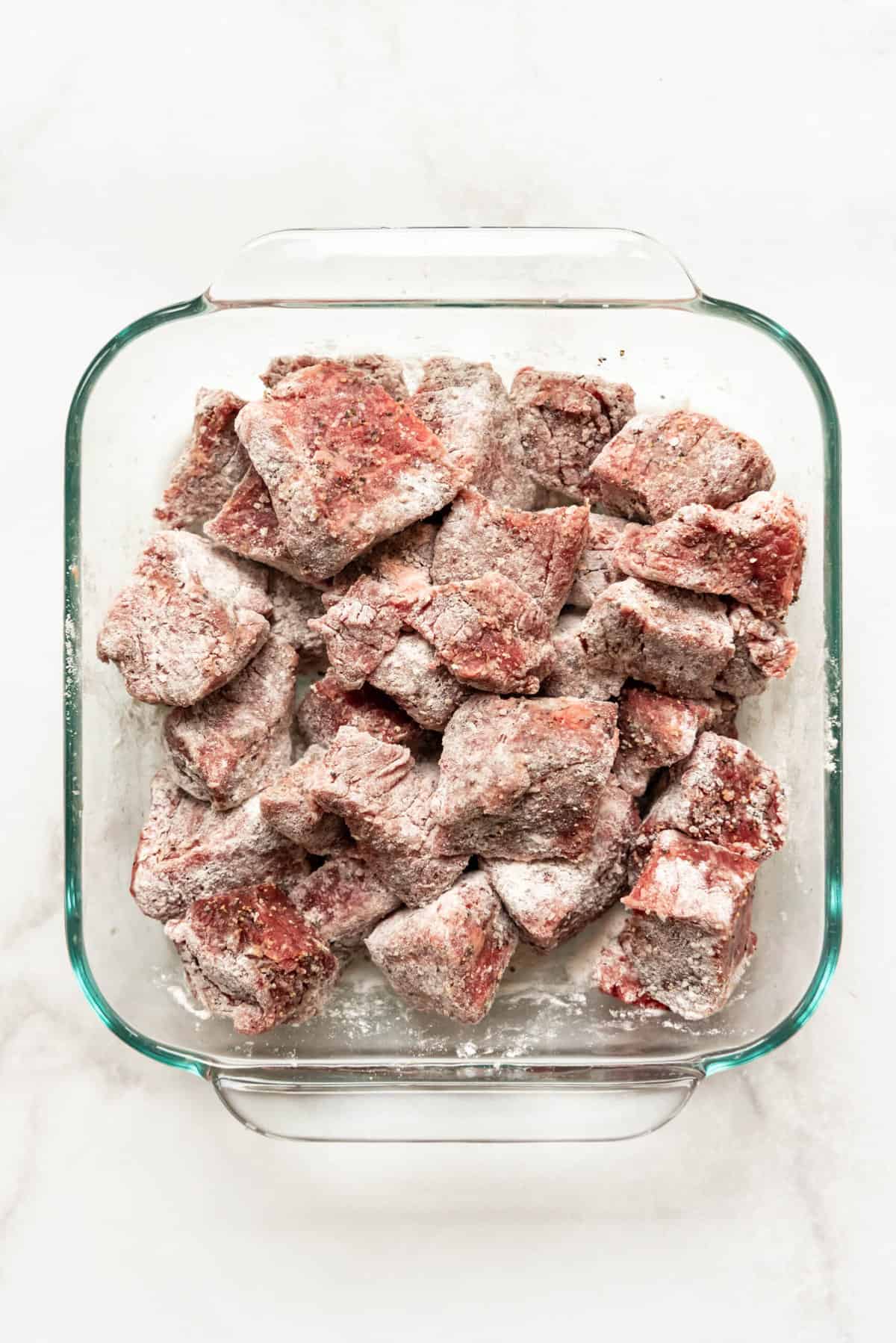
- Brown beef. Brown the beef in a large Dutch oven with hot oil on high heat. You will need to do this in a single layer in batches. Brown a few pieces at a time on all sides, using a wooden spoon to stir the beef in the pot. It’ll take about 5 minutes per batch. Transfer to a plate as finished and set aside.

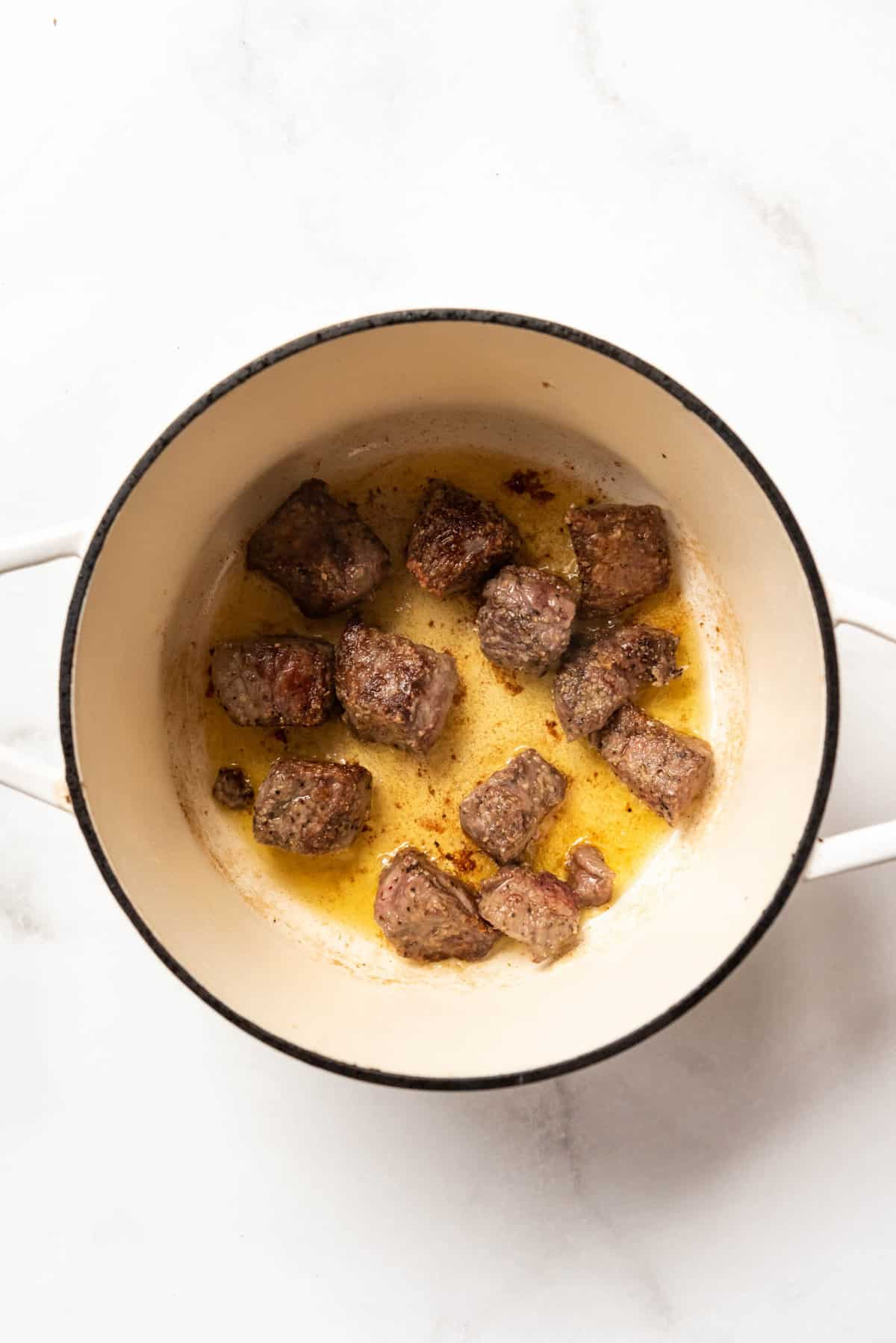
- Cook onions and carrots. Add onions to the same large pot that the meat was seared in and cook for about 4-5 minutes to soften slightly and get some color. Add garlic during the last minute of cooking.
- Add tomato paste. Stir in the tomato paste and cook for 1 minute to deepen the flavor.


- Deglaze pot. Deglaze the pot by adding the red wine and red wine vinegar and scraping the bottom of the pot to remove any browned bits. This gives the stew a deliciously rich flavor. Bring to a boil, then reduce the heat to medium-high.
- Add remaining ingredients. Return the seared meat to the pot along with the beef broth, bay leaves, carrots, celery, potatoes, Worcestershire sauce, and herbs.
- Cook. Bring to a boil then cover and reduce to a simmer for 2-3 hours until beef is tender. Another option would be to transfer the dutch oven to a 325°F oven to cook in there for the same amount of time.


- Season and add peas. Season with additional salt and pepper as needed, to taste. Add peas 2-3 minutes before serving, if using.

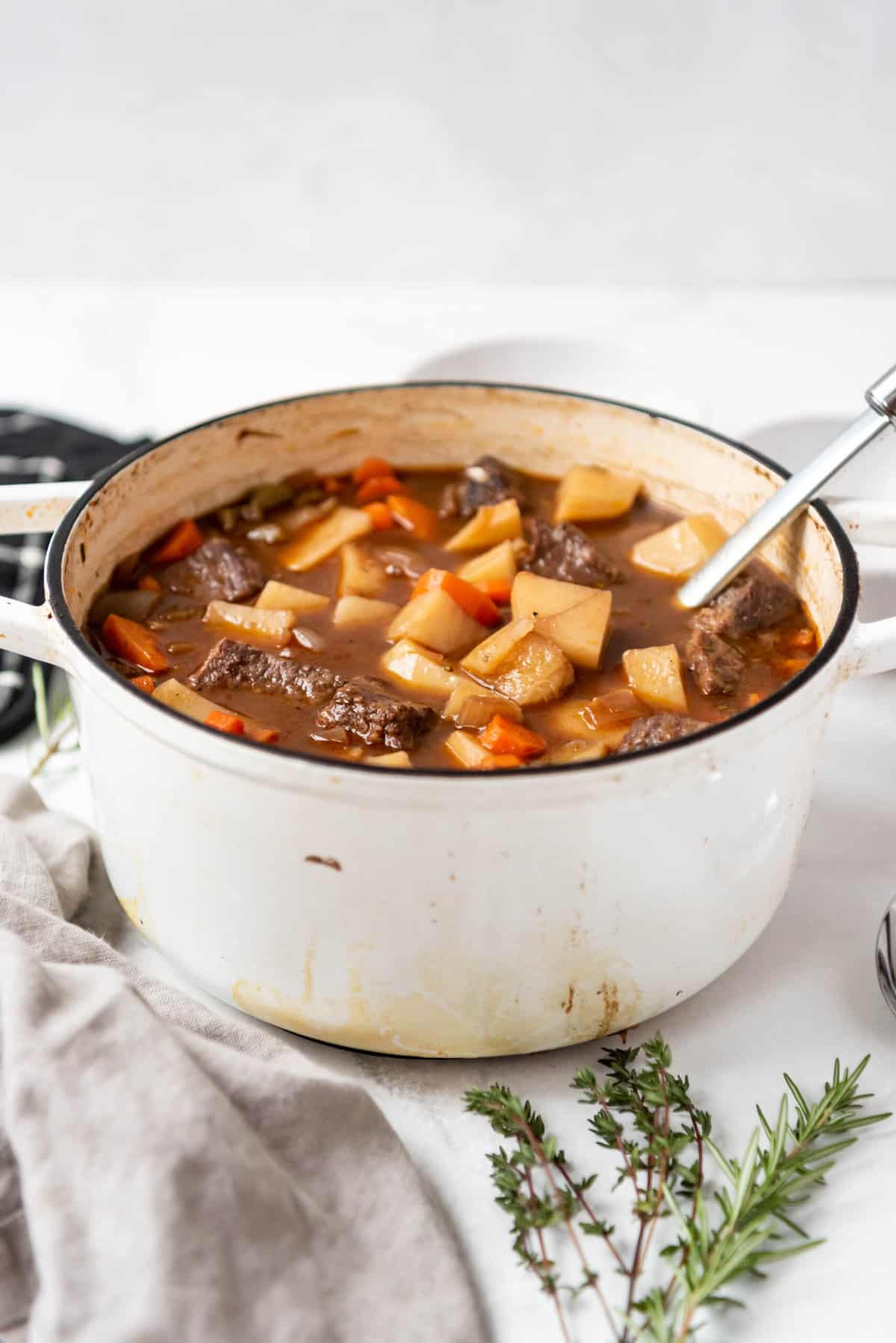
Traditional Beef Stew Recipe Tips
- Beef chunks. I love the large chunks of beef in this stew, but you can cut smaller cubes if you prefer. They should be super tender by the time the stew is done, but not falling apart.
- Browning beef. You don’t have to brown the beef before adding it to the stew, but I do recommend it. This simple extra step gives the beef a bit of a crisp outer crust and color, and the browned bits you’re left with at the bottom of the pan are so flavorful for the rest of the stew!
- Make Ahead. For the best flavor, make the day before! Make the stew, let it cool completely, then store it in the fridge overnight for the flavors to fully meld together and mature before reheating and serving the next day. Honestly the leftovers are my favorite!
Old Fashioned Beef Stew Substitutions & Variations
- Without wine: Substitute the red wine with additional beef broth or just water if you want to make it wine-free.
- Crock Pot Beef Stew: You can absolutely cook this stew in a slow cooker. Add browned beef and cooked onions to the slow cooker, with the remaining ingredients (except the peas). Cover and cook on LOW for 6-8 hours, or on HIGH for 3-4 hours, until vegetables are tender. Add peas and season to taste before serving.
- Instant Pot Beef Stew: Sear the beef and soften the onions using the SAUTE function before adding the rest of the ingredients (except the peas) and sealing the Instant Pot. Set the pressure cooker to cook at high pressure for 35 minutes, followed by a 10 minute natural release. Release any remaining pressure manually, then add the peas.
- Potatoes: The best potatoes to use are Russet potatoes or Yukon gold potatoes, but red potatoes will work as well.
- Vegetables: Add in your favorite vegetables, or use seasonal veggies if you like. Parsnip, mushrooms, leeks, cabbage, broccoli, and cauliflower would all work well in stews in varying combinations.
- Bacon: Cook some chopped bacon with the onion to add some smoky flavor to the stew!
- Beef stock: You can use beef stock instead of beef broth in a pinch.
What to Serve with this Traditional Beef Stew Recipe
- Mashed Potatoes: Creamy mashed potatoes soak up the stew’s juices and add a comforting element to the meal.
- Crusty Bread or Dinner Rolls: A loaf of crusty bread or some warm dinner rolls are perfect for dipping into the stew or sopping up the sauce.
- Salad: A fresh green salad with a simple vinaigrette can provide a refreshing contrast to the richness of the stew.
- Cornbread: Its slightly sweet taste can balance the savory stew flavors and is a classic pairing.
- Polenta: Creamy polenta is a great alternative to mashed potatoes, offering a comforting base for the stew.
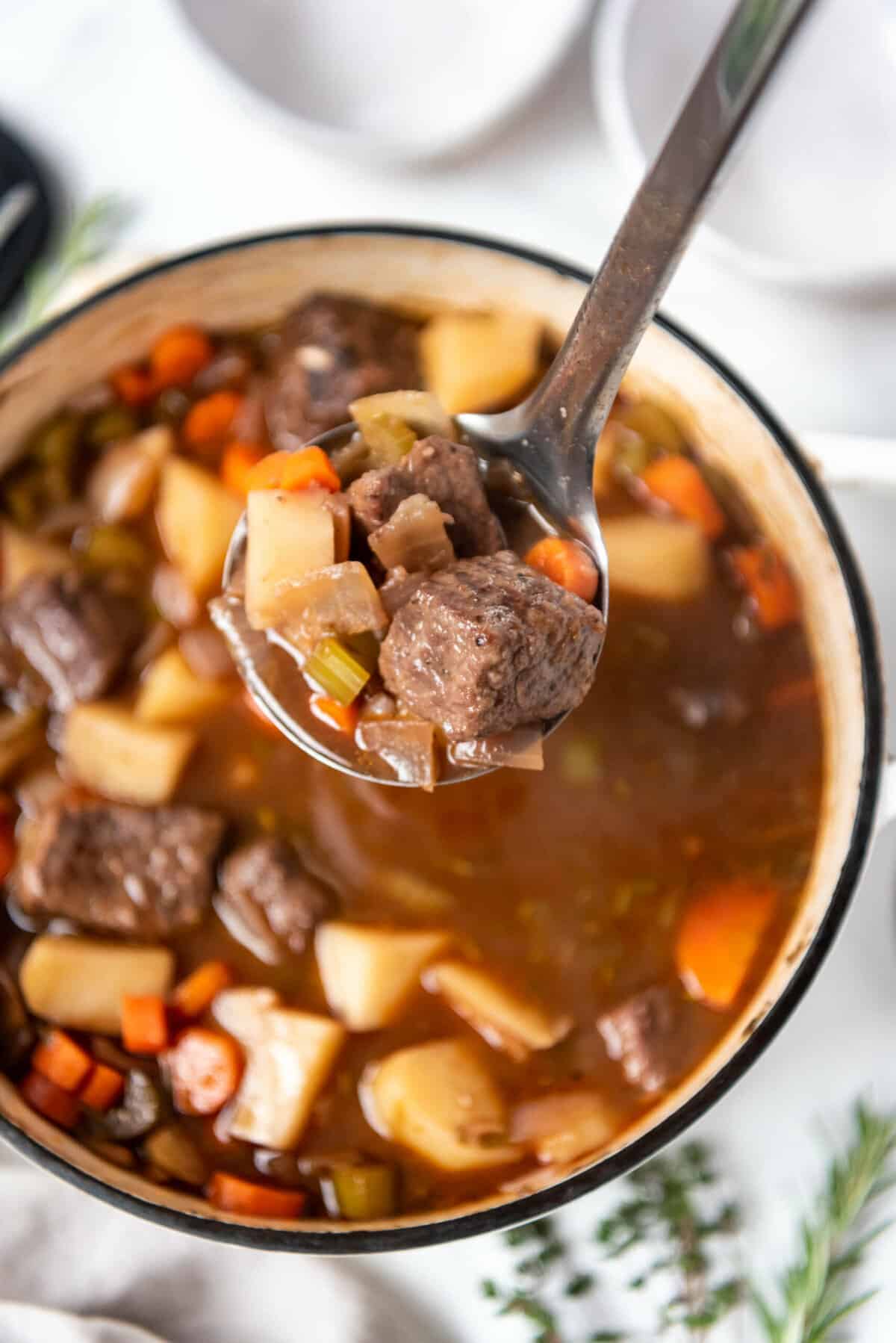

Best Old Fashioned Beef Stew Recipe FAQs
One of the secrets to a good stew is slow cooking. Cooking the stew over a long time allows the flavors to fully mature and meld together, and also allows the vegetables to fully cook through. You can definitely tell a difference when the stew has had plenty of time to simmer, which is one reason why stew leftovers are so good the next day.
I don’t love thick, gravy-like stew so this recipe will make a stew with a more soup-like liquid to it. If you prefer a thicker stew you can whisk together 2-3 tablespoons of cornstarch or arrowroot with 2-3 tablespoons cold water to make a slurry, then stir this in during the last 30 minutes of cooking to help thicken the sauce into more of a gravy. Also, if you use russet potatoes and let them break down by cooking them longer, that will also thicken the beef stew.
Store in an airtight container in the refrigerator for up to 4 days. Reheat on the stovetop on medium-high heat or cover and reheat in the oven at 350 degrees F until piping hot.
Yes! Beef stew freezes really well, so it’s great to make ahead and bring out portions when you need it. Store portioned in Ziploc bags for easy to thaw and reheat individual servings, or in a freezer-safe container for up to 3 months. Defrost in the refrigerator overnight and reheat in a pot on the stove or in the microwave until piping hot.
Potatoes, carrots, onion, and celery are all pretty standard stew additions because they impart savory flavor and hold up well when cooked. Mushrooms are also a popular stew addition, although I personally prefer my stew without them. Other root vegetables like turnips or parsnips would be good choices for adding to your stew, and you could even experiment by adding broccoli, cauliflower, cabbage, leek, or even kale as substitutes if you have some on hand that you want to use up.
Vinegar, especially types like red wine vinegar or balsamic vinegar, can add a tangy and slightly acidic flavor that complements the richness of the beef and the stew’s overall taste profile. It helps balance the flavors by cutting through the richness of the meat and other ingredients.
Yes, beef can become more tender the longer it’s stewed. Tougher cuts of beef, which typically have more connective tissue, benefit from longer cooking times at lower temperatures to break down these tough elements. Low and slow cooking methods, like stewing or braising, help break down these tough fibers, resulting in more tender meat. The longer the beef stew simmers, the more time it has to tenderize and become fork-tender.
The best potatoes for beef stew are those that hold their shape and texture well during cooking, providing a creamy yet sturdy addition to the dish. Yukon Golds have a creamy texture and slightly waxy consistency that holds up well in stews without becoming overly mushy. They add a nice richness to the stew. Red potatoes have a smooth, thin skin and a waxy texture, red potatoes hold their shape nicely during cooking. While they are more starchy and have a tendency to break down more easily, we enjoy Russet potatoes for the thicker texture they bring to stews. They can help thicken the stew as they break down, adding a hearty quality.
Ultimately, the choice depends on personal preference. Some prefer potatoes that retain their shape, while others enjoy how starchier varieties break down and thicken the stew.
If you prefer not to cook with wine or don’t have any on hand for your beef stew, you can simply replace that liquid with the same amount of additional beef broth.
Chuck roast is the best choice for beef stew, in our opinion. It’s flavorful and contains a good amount of marbling and connective tissue, which breaks down beautifully during cooking, resulting in a tender texture.
Brisket is another well-marbled cut that is known for its rich flavor. It can take longer cooking times but rewards with tender, succulent meat in a stew.
Bottom round or top round cuts are leaner options and are often cubed and labeled as “stew meat” at the grocery store. While they’re not as marbled, they can still work well for stewing when cooked slowly and at a lower temperature.
Cutting the beef into smaller, bite-sized pieces can help it cook faster and become tender more quickly. This increases the surface area exposed to heat, aiding in faster cooking and tenderization.
Opt for pressure cooking or using a pressure cooker if you’re looking for a quicker stew. Pressure cooking can significantly reduce cooking time and tenderize the beef faster due to the increased pressure and heat.
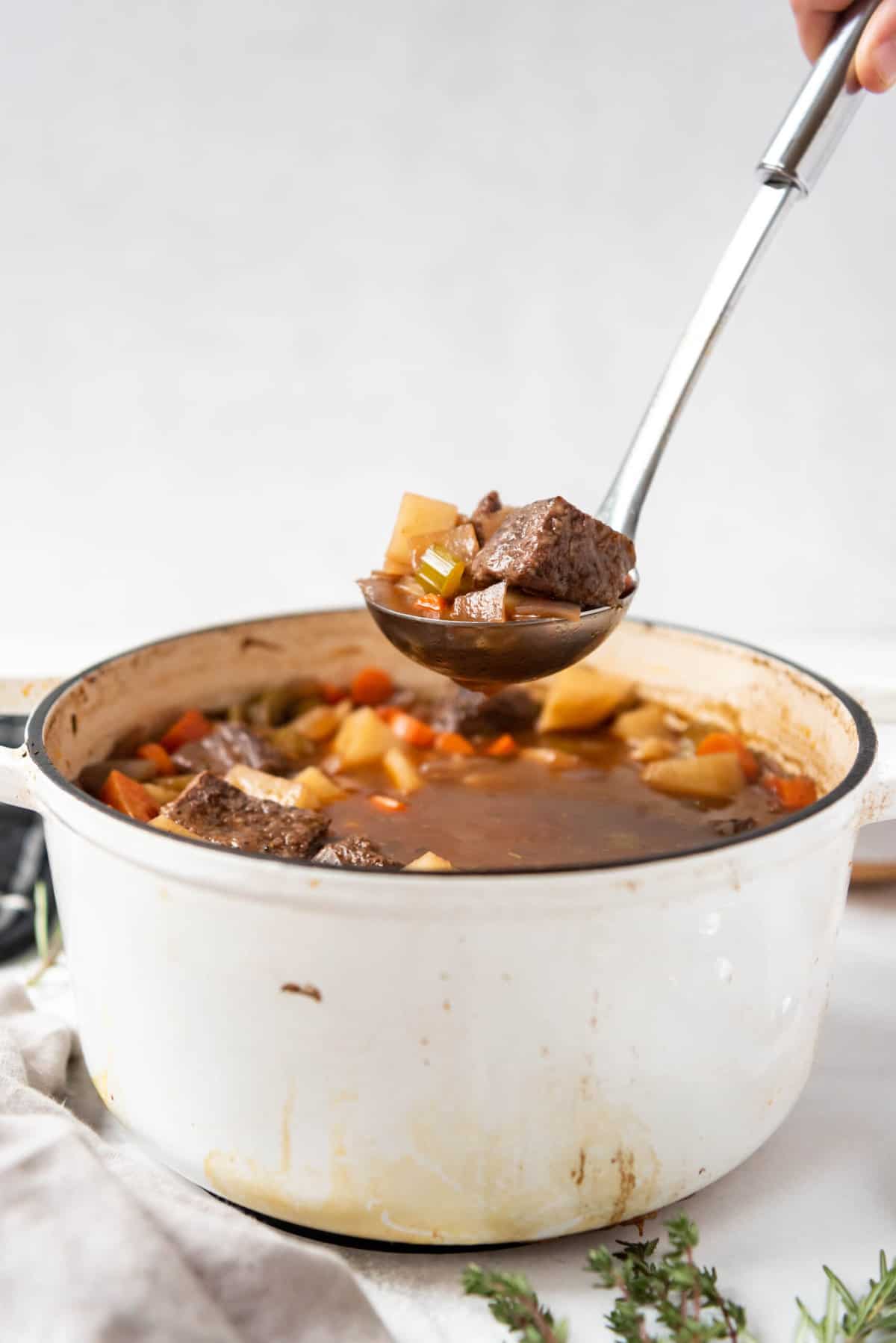
Traditional Beef Stew Seasonings
You can mix up the herbs, meat choice, or vegetables in stews to change the flavors, but there are some combinations that work better than others.
In a traditional beef stew, you’ll find a mixture of dried herbs like thyme, oregano, rosemary, and sage or herbs de Provence.
But you can use whole fresh thyme or fresh rosemary sprigs in the stew as it cooks then remove the sprigs for serving when you remove the bay leaves too.
If you want to change up your protein, you might consider varying the seasonings to create a new flavor profile for your stew. The following are great herb combinations if you’re changing it up:
- Chicken: Use basil, parsley, and/or tarragon and replace the beef broth with chicken broth for a delicious chicken stew.
- Lamb: This is one of our favorite proteins and it pairs beautifully with parsley, oregano, or rosemary as the main flavor. Cut up a lamb roast as you would a beef chuck roast and use it with beef broth to create a lamb stew.
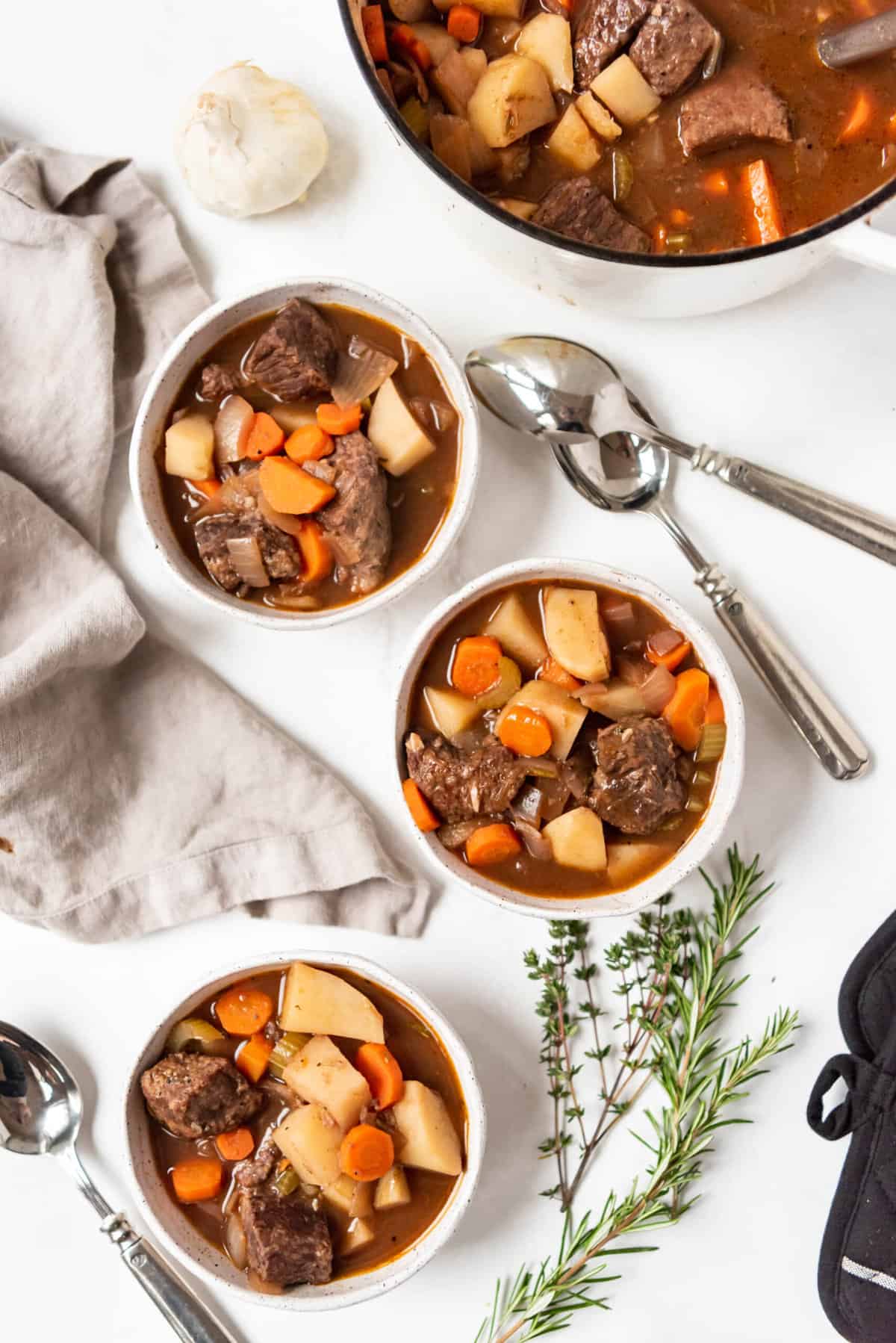
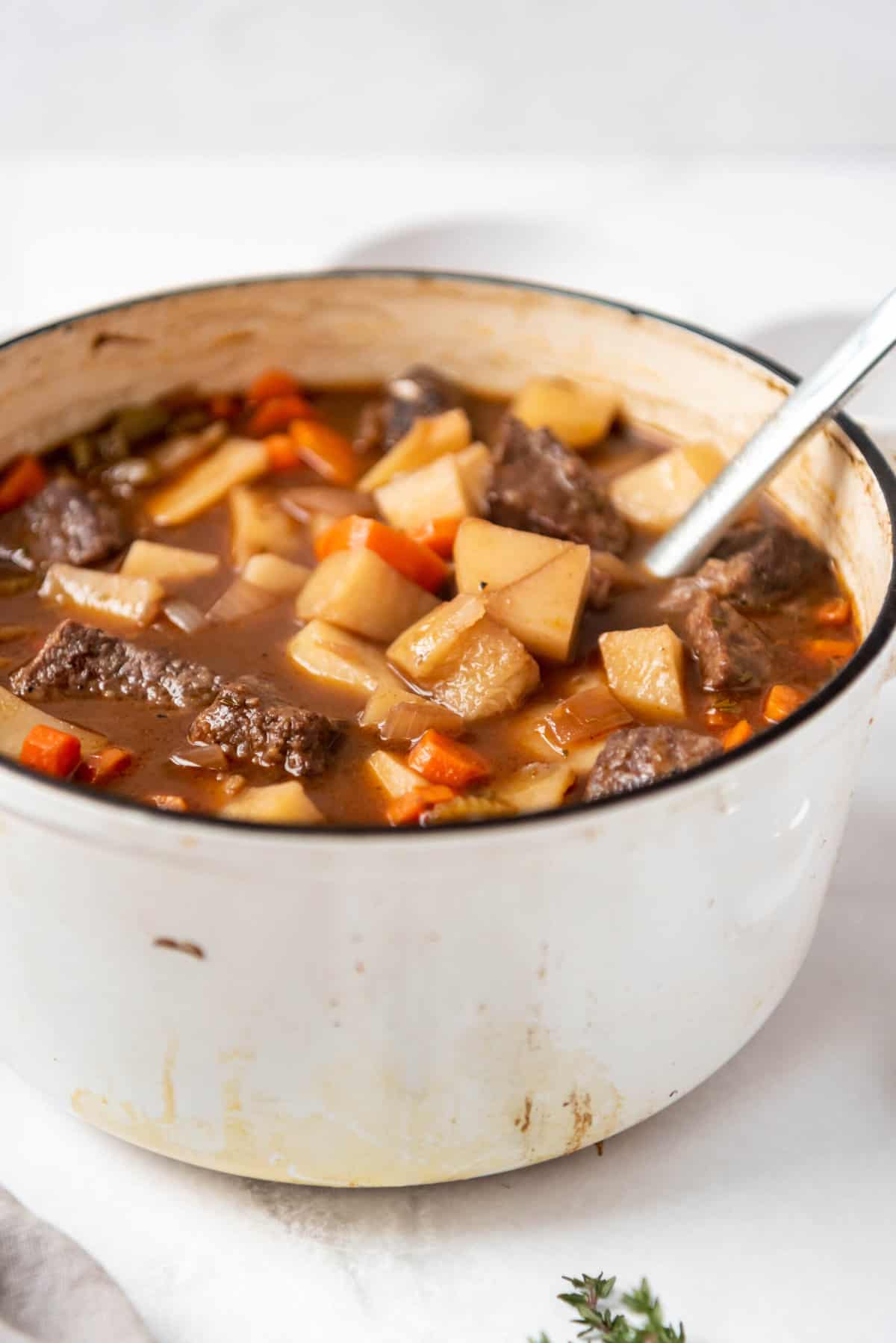
More like this Old Fashioned Beef Stew
- Easy Minestrone Soup
- Chicken Noodle & Dumpling Soup
- Cheesy Lasagna Soup
- Lemon Chicken Orzo Soup
- Homemade Tomato Basil Soup
Soup Recipes
Tortellini Soup with Italian Sausage
Soup Recipes
New England Clam Chowder Recipe
Soup Recipes
The Best Loaded Baked Potato Soup
Did you make this recipe?
Let me know what you thought with a comment and rating below. You can also take a picture and tag me on Instagram @houseofnasheats or share it on the Pinterest pin so I can see.
Old Fashioned Beef Stew (Dutch Oven)
Ingredients
- 2 to 2 1/2 pounds beef chuck roast or beef stewing meat, cut into 1" to 1 1/2" cubes
- ½ cup all-purpose flour
- 1 Tablespoons coarse kosher salt
- 1 teaspoon freshly ground black pepper
- 4 tablespoons vegetable oil
- 1 large onion, chopped
- 3 garlic cloves, minced
- 2 tablespoons tomato paste
- 1 cup red wine (optional – can be replaced with additional broth or water)
- 4 tablespoons red wine vinegar
- 6 cups beef broth
- 2 bay leaves
- 5-6 medium carrots, peeled and chopped into 1/4-inch discs
- 3-4 large russet potatoes, peeled and cut into 3/4-inch pieces
- 2 celery stalks
- 1 tablespoon Worcestershire sauce
- 2 tablespoons herbs de Provence or 1 Tablespoon each dried rosemary and dried thyme
- 2 cups frozen peas (optional)
Instructions
- Season beef all over with salt and pepper. Toss with flour.
- Brown in hot oil on high heat a few at a time on all sides (about 5 minutes per batch), adding more oil if needed. Transfer to a plate as finished and set aside.
- Add onions to the same pan that the meat was seared in and cook for about 4-5 minutes to soften slightly and get some color. Add garlic during the last minute of cooking.
- Stir in the tomato paste and cook for 1 minute to deepen the flavor.
- Deglaze the pan by adding the red wine and red wine vinegar and scraping the bottom of the pot to remove any browned bits. Bring to a boil, then reduce the heat to medium-high.
- Return the seared meat to the pot along with the beef broth, bay leaves, carrots, potatoes, celery, Worcestershire sauce, and herbs. Bring to a boil then cover and reduce to a simmer for 2-3 hours until beef is tender. Another option would be to transfer the dutch oven to a 325°F oven to cook in there for the same amount of time until the meat and veggies are tender.
- Season with additional salt and pepper as needed, to taste. Add peas 2-3 minutes before serving, if using.
Notes
- Storage: Store in an airtight container in the refrigerator for up to 4 days. Reheat on the stovetop on medium-high heat or cover and reheat in the oven at 350 degrees F until piping hot.
- Freeze: Store the beef stew, portioned in Ziploc bags, or as a whole in a freezer-safe container for up to 3 months. Defrost in the refrigerator overnight and reheat in a pot on the stove or in the microwave until piping hot.
- Without wine: Substitute the red wine with additional beef broth or just water if you want to make it wine-free.
- Crock Pot Beef Stew: You can absolutely cook this stew in a slow cooker. Add browned beef and cooked onions to the slow cooker, with the remaining ingredients (except the peas). Cover and cook on LOW for 6-8 hours, or on HIGH for 3-4 hours, until vegetables are tender. Add peas and season to taste before serving.
- Instant Pot Beef Stew: Sear the beef and soften the onions using the SAUTE function before adding the rest of the ingredients (except the peas) and sealing the Instant Pot. Set the pressure cooker to cook at high pressure for 35 minutes, followed by a 10 minute natural release. Release any remaining pressure manually, then add the peas.
